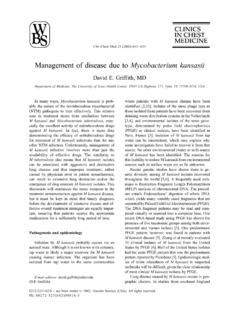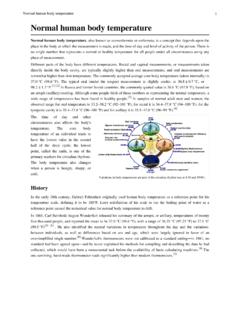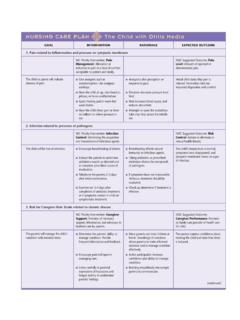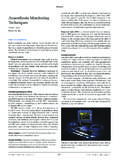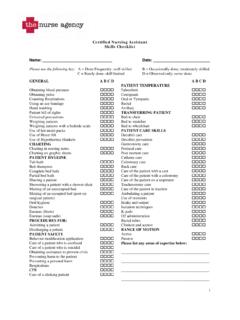Transcription of Hypothermia, Hyperthermia, and Rhabdomyolysis
1 hypothermia , Hyperthermia, and Rhabdomyolysis Janice L. Zimmerman, MD, FCCP. Objectives: tone and shivering. These homeostatic mechanisms To understand the physiologic responses associated with deteriorate with age. hypothermia To outline supportive measures and rewarming techniques for management of hypothermia hypothermia To describe predisposing factors for heat stroke, the clinical manifestations, and cooling methods Definition and Etiologies To discuss the clinical presentations and management of malignant hyperthermia and neuroleptic malignant syn- drome hypothermia is defined as the unintentional To describe etiologies, clinical presentation, and treatment lowering of core body temperature (tympanic, of Rhabdomyolysis esophageal, or rectal) to < 35 C (< 95 F). Multiple factors may lead to increased heat loss, decreased Key words: heat stroke; hyperthermia; hypothermia ; ma- lignant hyperthermia; neuroleptic malignant syndrome.
2 Heat production, or impaired thermoregulation Rhabdomyolysis (Table 1). hypothermia may be characterized as primary (accidental), due to exposure to cold tem- peratures, or secondary, resulting from a disease process such as myxedema or sepsis. Exposure is often found in hypothermic patients, along with Temperature Regulation underlying chronic disease processes or impairment from ethanol, drugs, or mental illness. Immersion T he balance between heat production and heat hypothermia is often distinguished from nonim- loss normally maintains the core body tempera- mersion hypothermia because it occurs more rap- ture at C ( F). Heat is produced idly and is more often accompanied by asphyxia. from the dissolution of high-energy bonds during hypothermia is frequently noted in trauma patients metabolism.
3 At rest, the trunk viscera supply 56% and is associated with increased mortality rates. of heat; during exercise, muscle activity may ac- To facilitate management and anticipate physi- count for 90% of generated heat. Heat production ologic changes, hypothermia can be classified by the may increase two- to fourfold with shivering and degree of temperature reduction. Mild hypothermia more than sixfold with exercise. Most heat loss (50 refers to core temperatures of 32 to 35 C (90 to 95 F);. to 70%) normally occurs through radiation. Con- moderate hypothermia , 28 to 32 C (82 to 90 F); and duction of heat through direct contact with cooler severe hypothermia , < 28 C (< 82 F). objects or loss of heat due to convection accounts for a smaller percentage of heat loss. Evaporation Pathophysiology of sweat from the skin is the major mechanism of heat loss in a warm environment.
4 General Metabolic Changes: hypothermia pro- The anterior hypothalamus is responsible duces multisystemic involvement that varies with for the perception of temperature and initiation of core temperature (Table 2). The initial response to physiologic responses. Information is received from cold is cutaneous vasoconstriction, which results in temperature-sensitive receptors in the skin, viscera, shunting of blood from colder extremities to the body and great vessels, as well as receptors located in the hy- core. Vasodilation secondary to ethanol can prevent pothalamus. When a temperature increase is sensed, this normal compensatory response. Vasoconstric- hypothalamic modulation results in increased sweat- tion fails at temperatures < 24 C (< 75 F), and the ing (a cholinergically mediated response), cutaneous rate of heat loss increases due to relative vasodilation.
5 Vasodilation, and decreased muscle tone. Conversely, Heat production is increased two- to fivefold by the a decrease in temperature results in decreased sweat- onset of shivering with core temperatures of 30 to ing, cutaneous vasoconstriction, and increased muscle 35 C (86 to 95 F). Shivering continues until glycogen ACCP Critical Care Board Review 2003 321. stores are depleted, which usually occurs when the atropine). Cardiac function and blood pressure also body temperature reaches 30 C (86 F). decline proportionately as the core temperature de- Cardiovascular System: An initial tachycardia creases. Systemic vascular resistance predictably is followed by progressive bradycardia. The pulse increases. rate decreases by 50% when core temperature hypothermia produces a variety of myocar- reaches 28 C (82 F).
6 Bradycardia is secondary to dial conduction abnormalities. Atrial fibrillation alterations in conductivity and automaticity that is common and usually converts to sinus rhythm are generally refractory to standard treatment (eg, spontaneously during rewarming. At temperatures of < 29 C (< 84 F), ventricular fibrillation (VF) can occur spontaneously or be induced by movement Table 1. Factors Predisposing to hypothermia or invasive procedures (eg, central line, nasogastric Increased heat loss tube). Asystole occurs at temperatures < 20 C (< 68 F). Environmental exposure VF and other arrhythmias are extremely refractory Skin disorders to defibrillation and drug treatment until the core Burns temperature increases to ~30 C (~86 F). Dermatitis Psoriasis Although many ECG abnormalities have been Vasodilation described, the most characteristic of hypothermia Alcohol is the J wave (also called the Osborne wave) at the Drugs (phenothiazines).)
7 Iatrogenic junction of the QRS complex and ST segment (Fig Heat stroke treatment 1). The J wave can occur in patients with core tem- Environmental cold (operating suite) peratures of < 32 C (< 90 F) and it is almost always Decreased heat production present at temperatures of < 25 C (< 77 F). It has Endocrine disorders been observed that the size of the J wave may be Hypopituitarism Hypothyroidism inversely correlated with temperature. The presence Hypoadrenalism of this wave is not pathognomonic for hypothermia , Insufficient fuel nor does it have prognostic value. It is important Hypoglycemia Anorexia nervosa to distinguish J waves from ST segment elevation Malnutrition indicating myocardial infarction. Prolongation of Extreme exertion the P R, QRS, and Q T intervals may be noted. Neuromuscular inefficiency Other Organ Systems: As temperature de- Extremes of age Inactivity creases, tidal volume and respiratory rate will Impaired shivering decrease.
8 The cough reflex may be blunted, and Impaired thermoregulation cold-induced bronchorrhea may contribute to atel- Peripheral dysfunction ectasis. Hypoxemia may develop early depending Neuropathies on the circumstances (eg, water immersion, aspira- Spinal cord transection Diabetes tion). Although renal blood flow and glomerular Central dysfunction filtration rate decrease in hypothermia , there is an CNS hemorrhage/trauma initial cold-induced diuresis due to the relative Cerebrovascular accident Drugs central hypervolemia resulting from peripheral Sedatives vasoconstriction. Additional contributory factors Alcohols include the inhibition of antidiuretic hormone Cyclic antidepressants release and renal tubular concentrating defects. Narcotics Neoplasm Ethanol exacerbates the diuresis. With warming, Parkinson's disease volume depletion may become evident.
9 Anorexia nervosa With mild hypothermia , victims may ex- Miscellaneous states hibit confusion, lethargy, or combativeness. Sepsis Pancreatitis Below a core temperature of 32 C (90 F), the Carcinomatosis patient is usually unconscious with diminished Uremia brainstem function. Pupils dilate below a core Giant cell arteritis temperature of 30 C (86 F). Intestinal motility Sarcoidosis decreases at < 34 C (< 93 F), resulting in the com- 322 hypothermia , Hyperthermia, and Rhabdomyolysis (Zimmerman). Table 2. Manifestations of hypothermia *. Core Temp ( C) Musculoskeletal Neurologic Other Mild hypothermia 36 Shivering begins Slurred speech 34 Maximal shivering Increased confusion 33 Decreased shivering Stupor Decreasing BP; respiratory alkalosis, cold diuresis Moderate hypothermia 32 Shivering nearly absent; Pupils dilated Arrhythmias; J waves on ECG.
10 Onset of muscle rigidity 30 DTRs absent Severe hypoventilation 28 Extreme muscle rigidity No voluntary movement Shock; inaudible heart sounds Severe hypothermia 26. 24 Patient appears dead Severe risk of VF; minimal cardiac activity 22. 20 Isoelectric EEG Asystole 18 Isoelectric EEG Asystole *DTR = deep tendon reflex. To convert Celsius to Fahrenheit temperature, multiply by 9/5, then add 32. Figure 1. ECG of hypothermic patient showing J wave (arrow). ACCP Critical Care Board Review 2003 323. mon finding of ileus. Hepatic dysfunction affects the registering lower temperatures. A rectal probe generation of glucose as well as drug metabolism. is most practical even though it may lag behind Laboratory Findings: The physiologic changes core changes. The probe should be inserted to an described are reflected by clinical laboratory tests.
